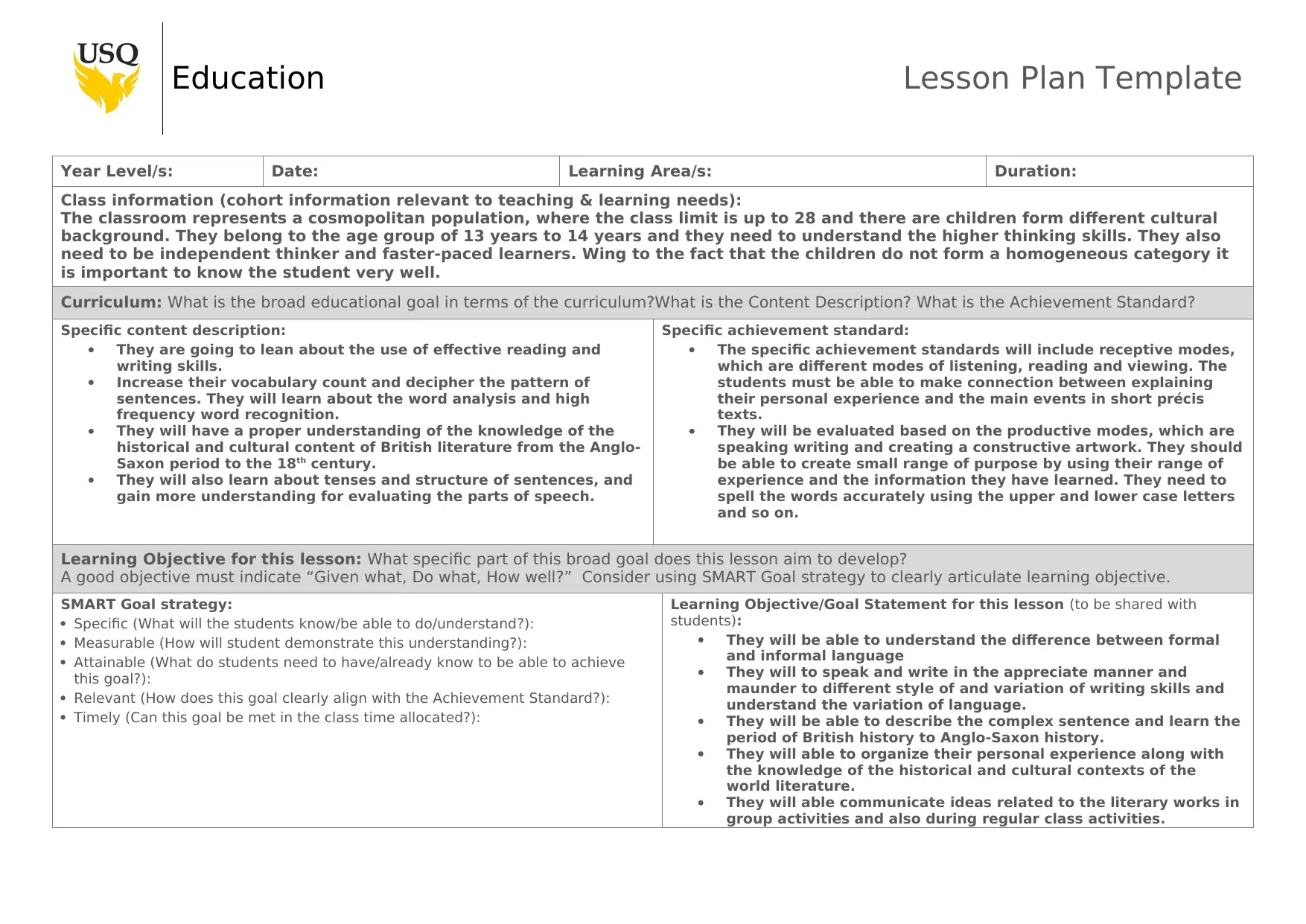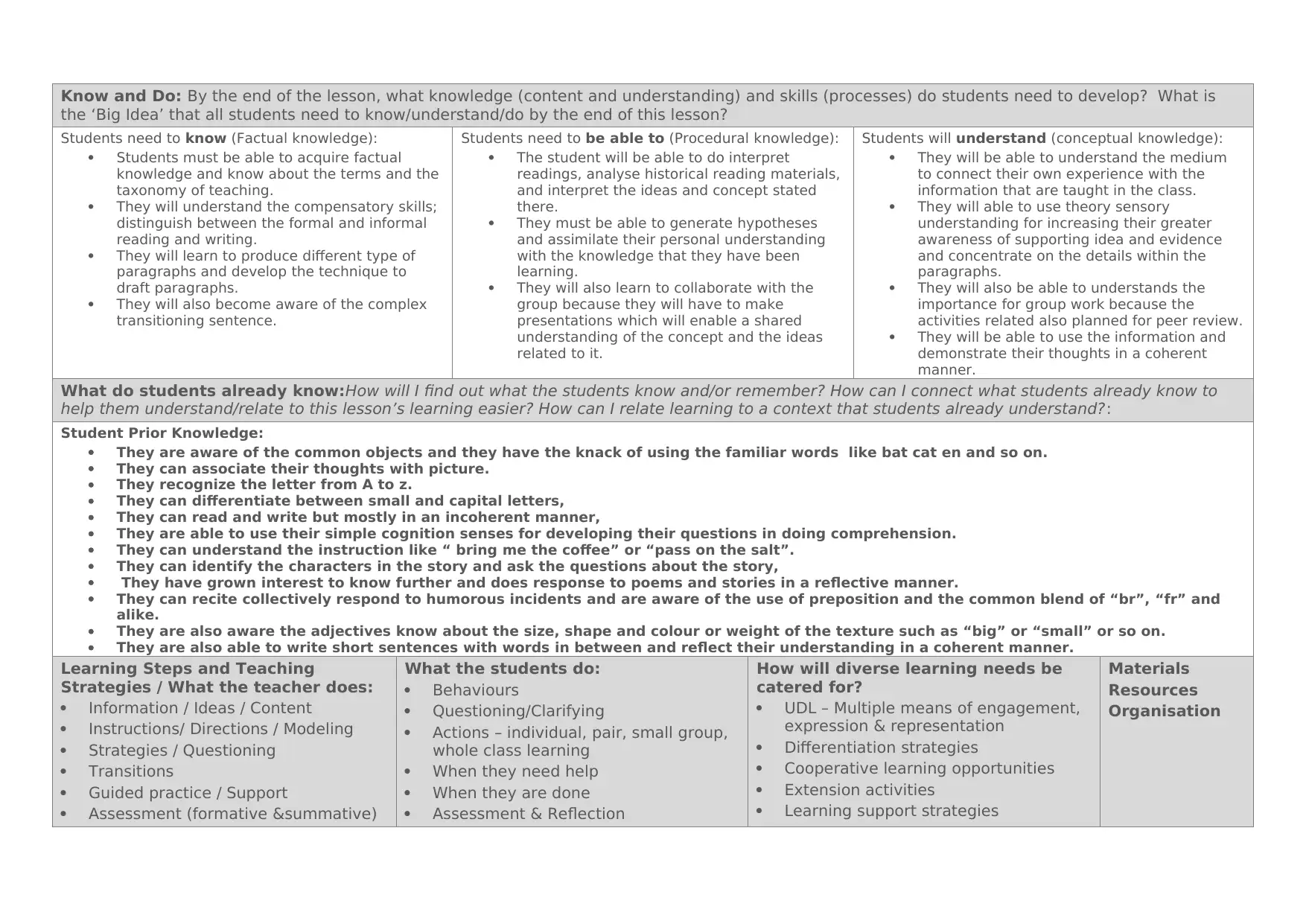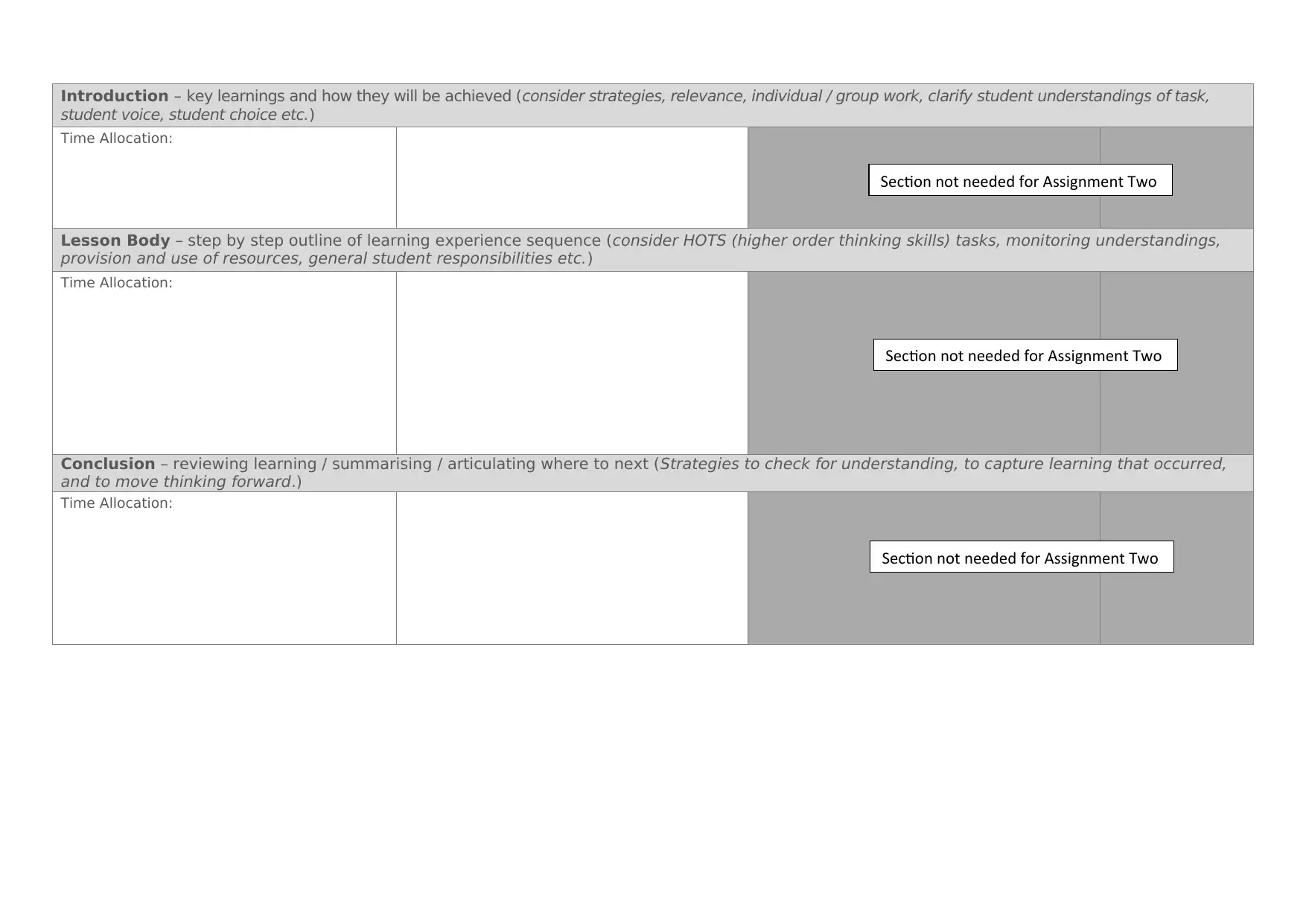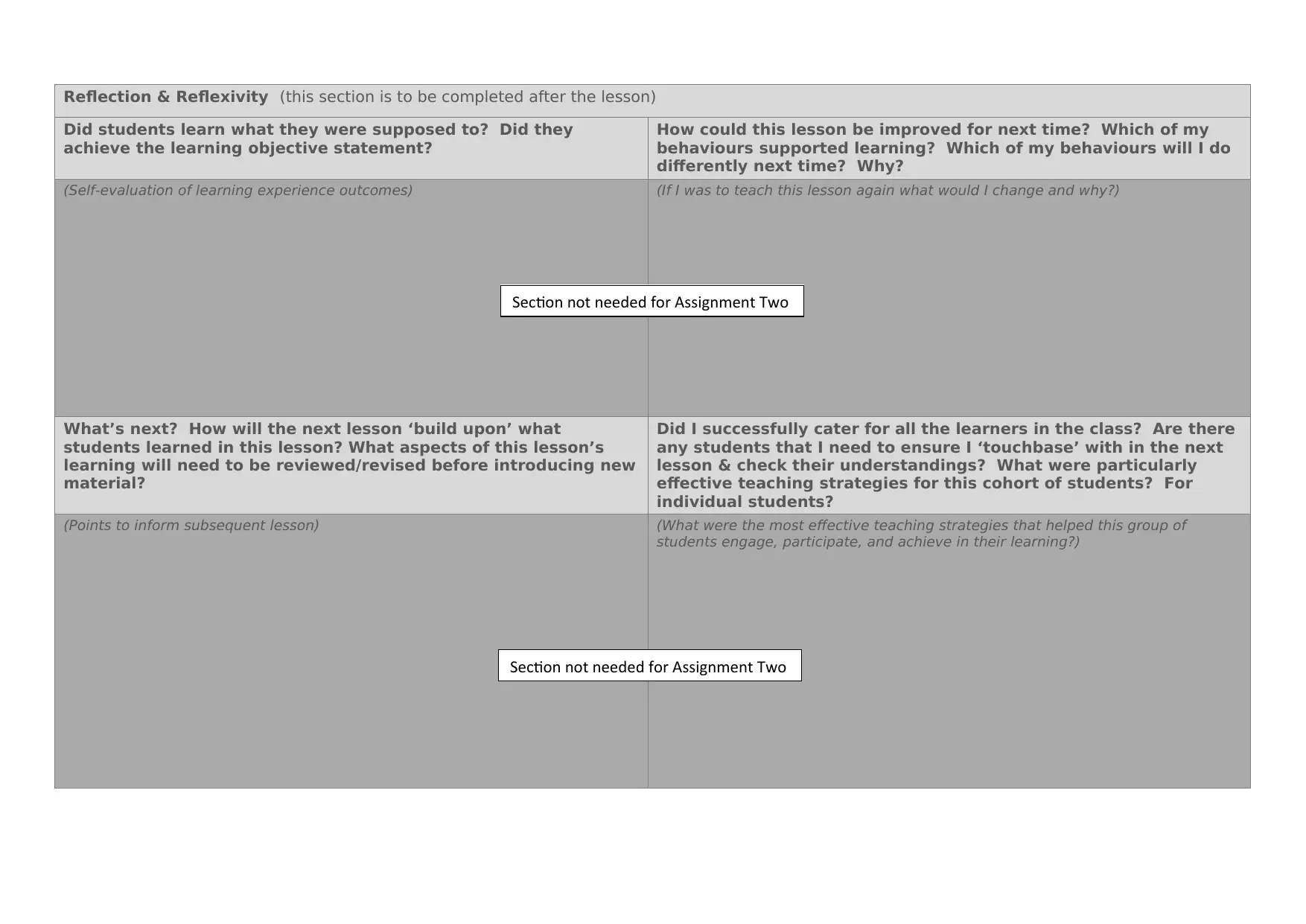Education Lesson Plan Template: ESF1100 Educator as Professional
VerifiedAdded on 2023/04/04
|4
|1452
|81
Practical Assignment
AI Summary
This assignment provides a lesson plan template designed for an Education course, focusing on the 'Educator as Professional.' It covers various aspects of lesson planning, including curriculum alignment, specific content and achievement standards, learning objectives using the SMART goal strategy, and the knowledge and skills students should develop. The template emphasizes understanding students' prior knowledge, incorporating diverse learning needs, and using effective teaching strategies. It also includes sections for reflection and future planning. The lesson plan aims to enhance students' reading, writing, and analytical skills while connecting their personal experiences with historical and cultural contexts of literature. Find more solved assignments and past papers on Desklib.

Education Lesson Plan Template
Year Level/s: Date: Learning Area/s: Duration:
Class information (cohort information relevant to teaching & learning needs):
The classroom represents a cosmopolitan population, where the class limit is up to 28 and there are children form different cultural
background. They belong to the age group of 13 years to 14 years and they need to understand the higher thinking skills. They also
need to be independent thinker and faster-paced learners. Wing to the fact that the children do not form a homogeneous category it
is important to know the student very well.
Curriculum: What is the broad educational goal in terms of the curriculum?What is the Content Description? What is the Achievement Standard?
Specific content description:
They are going to lean about the use of effective reading and
writing skills.
Increase their vocabulary count and decipher the pattern of
sentences. They will learn about the word analysis and high
frequency word recognition.
They will have a proper understanding of the knowledge of the
historical and cultural content of British literature from the Anglo-
Saxon period to the 18th century.
They will also learn about tenses and structure of sentences, and
gain more understanding for evaluating the parts of speech.
Specific achievement standard:
The specific achievement standards will include receptive modes,
which are different modes of listening, reading and viewing. The
students must be able to make connection between explaining
their personal experience and the main events in short précis
texts.
They will be evaluated based on the productive modes, which are
speaking writing and creating a constructive artwork. They should
be able to create small range of purpose by using their range of
experience and the information they have learned. They need to
spell the words accurately using the upper and lower case letters
and so on.
Learning Objective for this lesson: What specific part of this broad goal does this lesson aim to develop?
A good objective must indicate “Given what, Do what, How well?” Consider using SMART Goal strategy to clearly articulate learning objective.
SMART Goal strategy:
Specific (What will the students know/be able to do/understand?):
Measurable (How will student demonstrate this understanding?):
Attainable (What do students need to have/already know to be able to achieve
this goal?):
Relevant (How does this goal clearly align with the Achievement Standard?):
Timely (Can this goal be met in the class time allocated?):
Learning Objective/Goal Statement for this lesson (to be shared with
students):
They will be able to understand the difference between formal
and informal language
They will to speak and write in the appreciate manner and
maunder to different style of and variation of writing skills and
understand the variation of language.
They will be able to describe the complex sentence and learn the
period of British history to Anglo-Saxon history.
They will able to organize their personal experience along with
the knowledge of the historical and cultural contexts of the
world literature.
They will able communicate ideas related to the literary works in
group activities and also during regular class activities.
Year Level/s: Date: Learning Area/s: Duration:
Class information (cohort information relevant to teaching & learning needs):
The classroom represents a cosmopolitan population, where the class limit is up to 28 and there are children form different cultural
background. They belong to the age group of 13 years to 14 years and they need to understand the higher thinking skills. They also
need to be independent thinker and faster-paced learners. Wing to the fact that the children do not form a homogeneous category it
is important to know the student very well.
Curriculum: What is the broad educational goal in terms of the curriculum?What is the Content Description? What is the Achievement Standard?
Specific content description:
They are going to lean about the use of effective reading and
writing skills.
Increase their vocabulary count and decipher the pattern of
sentences. They will learn about the word analysis and high
frequency word recognition.
They will have a proper understanding of the knowledge of the
historical and cultural content of British literature from the Anglo-
Saxon period to the 18th century.
They will also learn about tenses and structure of sentences, and
gain more understanding for evaluating the parts of speech.
Specific achievement standard:
The specific achievement standards will include receptive modes,
which are different modes of listening, reading and viewing. The
students must be able to make connection between explaining
their personal experience and the main events in short précis
texts.
They will be evaluated based on the productive modes, which are
speaking writing and creating a constructive artwork. They should
be able to create small range of purpose by using their range of
experience and the information they have learned. They need to
spell the words accurately using the upper and lower case letters
and so on.
Learning Objective for this lesson: What specific part of this broad goal does this lesson aim to develop?
A good objective must indicate “Given what, Do what, How well?” Consider using SMART Goal strategy to clearly articulate learning objective.
SMART Goal strategy:
Specific (What will the students know/be able to do/understand?):
Measurable (How will student demonstrate this understanding?):
Attainable (What do students need to have/already know to be able to achieve
this goal?):
Relevant (How does this goal clearly align with the Achievement Standard?):
Timely (Can this goal be met in the class time allocated?):
Learning Objective/Goal Statement for this lesson (to be shared with
students):
They will be able to understand the difference between formal
and informal language
They will to speak and write in the appreciate manner and
maunder to different style of and variation of writing skills and
understand the variation of language.
They will be able to describe the complex sentence and learn the
period of British history to Anglo-Saxon history.
They will able to organize their personal experience along with
the knowledge of the historical and cultural contexts of the
world literature.
They will able communicate ideas related to the literary works in
group activities and also during regular class activities.
Paraphrase This Document
Need a fresh take? Get an instant paraphrase of this document with our AI Paraphraser

Know and Do: By the end of the lesson, what knowledge (content and understanding) and skills (processes) do students need to develop? What is
the ‘Big Idea’ that all students need to know/understand/do by the end of this lesson?
Students need to know (Factual knowledge):
Students must be able to acquire factual
knowledge and know about the terms and the
taxonomy of teaching.
They will understand the compensatory skills;
distinguish between the formal and informal
reading and writing.
They will learn to produce different type of
paragraphs and develop the technique to
draft paragraphs.
They will also become aware of the complex
transitioning sentence.
Students need to be able to (Procedural knowledge):
The student will be able to do interpret
readings, analyse historical reading materials,
and interpret the ideas and concept stated
there.
They must be able to generate hypotheses
and assimilate their personal understanding
with the knowledge that they have been
learning.
They will also learn to collaborate with the
group because they will have to make
presentations which will enable a shared
understanding of the concept and the ideas
related to it.
Students will understand (conceptual knowledge):
They will be able to understand the medium
to connect their own experience with the
information that are taught in the class.
They will able to use theory sensory
understanding for increasing their greater
awareness of supporting idea and evidence
and concentrate on the details within the
paragraphs.
They will also be able to understands the
importance for group work because the
activities related also planned for peer review.
They will be able to use the information and
demonstrate their thoughts in a coherent
manner.
What do students already know:How will I find out what the students know and/or remember? How can I connect what students already know to
help them understand/relate to this lesson’s learning easier? How can I relate learning to a context that students already understand?:
Student Prior Knowledge:
They are aware of the common objects and they have the knack of using the familiar words like bat cat en and so on.
They can associate their thoughts with picture.
They recognize the letter from A to z.
They can differentiate between small and capital letters,
They can read and write but mostly in an incoherent manner,
They are able to use their simple cognition senses for developing their questions in doing comprehension.
They can understand the instruction like “ bring me the coffee” or “pass on the salt”.
They can identify the characters in the story and ask the questions about the story,
They have grown interest to know further and does response to poems and stories in a reflective manner.
They can recite collectively respond to humorous incidents and are aware of the use of preposition and the common blend of “br”, “fr” and
alike.
They are also aware the adjectives know about the size, shape and colour or weight of the texture such as “big” or “small” or so on.
They are also able to write short sentences with words in between and reflect their understanding in a coherent manner.
Learning Steps and Teaching
Strategies / What the teacher does:
Information / Ideas / Content
Instructions/ Directions / Modeling
Strategies / Questioning
Transitions
Guided practice / Support
Assessment (formative &summative)
What the students do:
Behaviours
Questioning/Clarifying
Actions – individual, pair, small group,
whole class learning
When they need help
When they are done
Assessment & Reflection
How will diverse learning needs be
catered for?
UDL – Multiple means of engagement,
expression & representation
Differentiation strategies
Cooperative learning opportunities
Extension activities
Learning support strategies
Materials
Resources
Organisation
the ‘Big Idea’ that all students need to know/understand/do by the end of this lesson?
Students need to know (Factual knowledge):
Students must be able to acquire factual
knowledge and know about the terms and the
taxonomy of teaching.
They will understand the compensatory skills;
distinguish between the formal and informal
reading and writing.
They will learn to produce different type of
paragraphs and develop the technique to
draft paragraphs.
They will also become aware of the complex
transitioning sentence.
Students need to be able to (Procedural knowledge):
The student will be able to do interpret
readings, analyse historical reading materials,
and interpret the ideas and concept stated
there.
They must be able to generate hypotheses
and assimilate their personal understanding
with the knowledge that they have been
learning.
They will also learn to collaborate with the
group because they will have to make
presentations which will enable a shared
understanding of the concept and the ideas
related to it.
Students will understand (conceptual knowledge):
They will be able to understand the medium
to connect their own experience with the
information that are taught in the class.
They will able to use theory sensory
understanding for increasing their greater
awareness of supporting idea and evidence
and concentrate on the details within the
paragraphs.
They will also be able to understands the
importance for group work because the
activities related also planned for peer review.
They will be able to use the information and
demonstrate their thoughts in a coherent
manner.
What do students already know:How will I find out what the students know and/or remember? How can I connect what students already know to
help them understand/relate to this lesson’s learning easier? How can I relate learning to a context that students already understand?:
Student Prior Knowledge:
They are aware of the common objects and they have the knack of using the familiar words like bat cat en and so on.
They can associate their thoughts with picture.
They recognize the letter from A to z.
They can differentiate between small and capital letters,
They can read and write but mostly in an incoherent manner,
They are able to use their simple cognition senses for developing their questions in doing comprehension.
They can understand the instruction like “ bring me the coffee” or “pass on the salt”.
They can identify the characters in the story and ask the questions about the story,
They have grown interest to know further and does response to poems and stories in a reflective manner.
They can recite collectively respond to humorous incidents and are aware of the use of preposition and the common blend of “br”, “fr” and
alike.
They are also aware the adjectives know about the size, shape and colour or weight of the texture such as “big” or “small” or so on.
They are also able to write short sentences with words in between and reflect their understanding in a coherent manner.
Learning Steps and Teaching
Strategies / What the teacher does:
Information / Ideas / Content
Instructions/ Directions / Modeling
Strategies / Questioning
Transitions
Guided practice / Support
Assessment (formative &summative)
What the students do:
Behaviours
Questioning/Clarifying
Actions – individual, pair, small group,
whole class learning
When they need help
When they are done
Assessment & Reflection
How will diverse learning needs be
catered for?
UDL – Multiple means of engagement,
expression & representation
Differentiation strategies
Cooperative learning opportunities
Extension activities
Learning support strategies
Materials
Resources
Organisation

Introduction – key learnings and how they will be achieved (consider strategies, relevance, individual / group work, clarify student understandings of task,
student voice, student choice etc.)
Time Allocation:
Lesson Body – step by step outline of learning experience sequence (consider HOTS (higher order thinking skills) tasks, monitoring understandings,
provision and use of resources, general student responsibilities etc.)
Time Allocation:
Conclusion – reviewing learning / summarising / articulating where to next (Strategies to check for understanding, to capture learning that occurred,
and to move thinking forward.)
Time Allocation:
Section not needed for Assignment Two
Section not needed for Assignment Two
Section not needed for Assignment Two
student voice, student choice etc.)
Time Allocation:
Lesson Body – step by step outline of learning experience sequence (consider HOTS (higher order thinking skills) tasks, monitoring understandings,
provision and use of resources, general student responsibilities etc.)
Time Allocation:
Conclusion – reviewing learning / summarising / articulating where to next (Strategies to check for understanding, to capture learning that occurred,
and to move thinking forward.)
Time Allocation:
Section not needed for Assignment Two
Section not needed for Assignment Two
Section not needed for Assignment Two
⊘ This is a preview!⊘
Do you want full access?
Subscribe today to unlock all pages.

Trusted by 1+ million students worldwide

Reflection & Reflexivity (this section is to be completed after the lesson)
Did students learn what they were supposed to? Did they
achieve the learning objective statement?
How could this lesson be improved for next time? Which of my
behaviours supported learning? Which of my behaviours will I do
differently next time? Why?
(Self-evaluation of learning experience outcomes) (If I was to teach this lesson again what would I change and why?)
What’s next? How will the next lesson ‘build upon’ what
students learned in this lesson? What aspects of this lesson’s
learning will need to be reviewed/revised before introducing new
material?
Did I successfully cater for all the learners in the class? Are there
any students that I need to ensure I ‘touchbase’ with in the next
lesson & check their understandings? What were particularly
effective teaching strategies for this cohort of students? For
individual students?
(Points to inform subsequent lesson) (What were the most effective teaching strategies that helped this group of
students engage, participate, and achieve in their learning?)
Section not needed for Assignment Two
Section not needed for Assignment Two
Did students learn what they were supposed to? Did they
achieve the learning objective statement?
How could this lesson be improved for next time? Which of my
behaviours supported learning? Which of my behaviours will I do
differently next time? Why?
(Self-evaluation of learning experience outcomes) (If I was to teach this lesson again what would I change and why?)
What’s next? How will the next lesson ‘build upon’ what
students learned in this lesson? What aspects of this lesson’s
learning will need to be reviewed/revised before introducing new
material?
Did I successfully cater for all the learners in the class? Are there
any students that I need to ensure I ‘touchbase’ with in the next
lesson & check their understandings? What were particularly
effective teaching strategies for this cohort of students? For
individual students?
(Points to inform subsequent lesson) (What were the most effective teaching strategies that helped this group of
students engage, participate, and achieve in their learning?)
Section not needed for Assignment Two
Section not needed for Assignment Two
1 out of 4
Related Documents
Your All-in-One AI-Powered Toolkit for Academic Success.
+13062052269
info@desklib.com
Available 24*7 on WhatsApp / Email
![[object Object]](/_next/static/media/star-bottom.7253800d.svg)
Unlock your academic potential
Copyright © 2020–2025 A2Z Services. All Rights Reserved. Developed and managed by ZUCOL.





